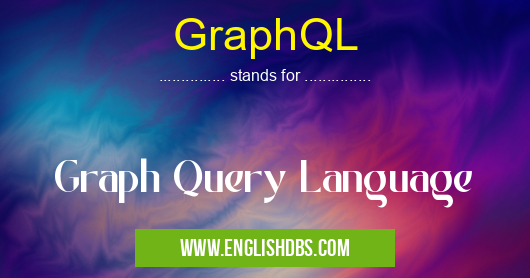What does GRAPHQL mean in SOFTWARE
GraphQL is a query language for APIs and a runtime for fulfilling those queries with your existing data. It provides a way to declare what data an API needs and expects, making it easier to develop applications that interact with the backend data sources. It allows clients to ask for exactly what they need from the server, and nothing more. GraphQL was created at Facebook in 2012 and made open source in 2015.

GraphQL meaning in Software in Computing
GraphQL mostly used in an acronym Software in Category Computing that means Graph Query Language
Shorthand: GraphQL,
Full Form: Graph Query Language
For more information of "Graph Query Language", see the section below.
What Is GraphQL?
GraphQL is a query language used to interact with data stored in an application’s backend. It is often used as an alternative to RESTful APIs, offering more flexibility to the client-side when retrieving data from the server. GraphQL enables clients to specify their own exact data requirements, which makes it easier for developers to build efficient applications that can query any kind of structured data quickly and accurately.
GraphQL consists of two parts: a query language used by clients and servers to define what kind of information they need, and a runtime that executes these queries against an existing API or database, returning only the requested information. By abstracting away the details of data storage or databases being used, developers can focus on writing code that actually gets executed in order to fulfill their requests. The query language also enables clients to get more control over how they access data, allowing them to specify fields they would like returned rather than having entire objects sent back or paginating through results one page at a time.
Advantages Of GraphQL
The main advantage of using GraphQL is its ability to optimize communication between apps and servers by allowing the client app request only precisely what it needs from the server rather than receiving larger payloads with potentially unused fields. This optimization can result in reduced latency when loading large amounts of data as well as improved performance when developing mobile applications since fewer network calls are needed in order for requests to be fulfilled. Additionally, given its strong typing system, errors can be detected earlier on during development since fields requested by the client app have pre-defined types that must match up correctly with fields defined on the server side before requests can be fulfilled successfully. Finally, GraphQL’s ability for nesting helps reduce complexity when querying multiple related entities; instead of having separate endpoints for each entity needing retrieval from the server, all related entities can instead be batched together within one single request containing nested objects as part of its payload structure which returns only what needs sending back - making it much easier for both client apps and servers alike!
Essential Questions and Answers on Graph Query Language in "COMPUTING»SOFTWARE"
What is GraphQL?
GraphQL is a query language used to interact with APIs. It provides an efficient, powerful and flexible alternative to traditional REST-based APIs. GraphQL allows clients to specify the data they need from an API, which eliminates over-fetching of data and reduces network latency.
What advantages does GraphQL provide compared to a REST API?
Unlike most REST APIs that return fixed JSON data structures, GraphQL allows you to query the exact data you need for your application. This makes it easier for developers to create complex applications without having to worry about excessive calls or parsing JSON data structures. Additionally, due to its flexibility, GraphQL can be used in combination with existing REST APIs.
How do I use GraphQL?
To use GraphQL, first define a schema with the desired types and fields that are accessible through the API. Then create resolvers that map each type and field to an appropriate backend service such as a database or remote API. Finally, use the client library of your choice (such as Apollo Client) to make queries against the server running your GraphQL schema.
What programming languages are required for developing with GraphQL?
Developing with GraphQL requires knowledge of JavaScript and TypeScript for creating schemas as well as understanding of several related libraries such as Apollo Server for building servers. However, since languages like Java also have support for various aspects of the technology, knowledge of non-JS languages can still be useful.
Is there a standard way to structure queries in GraphQL?
Yes! The official specification defines a query language syntax called graphql-js which enables developers to write their queries in a structured fashion using plain text strings or by using variables stored in objects. By following this syntax, it becomes easier for clients and servers alike to parse and execute queries efficiently.
Are there any rules regarding naming conventions that should be followed when writing queries in GraphQL?
Generally it is good practice to follow the same naming conventions you would normally use while coding. For example; all field names should be camelCase instead of snake_case when constructing your query string.
